Missa Thomas Cesus, SPB80, Folios 166v-81
Of the Masses in SPB80, one in particular can plausibly be associated with a Roman celebration, the anonymous Missa Thomas cesus (fols. 166v-81). Based on a segment of the rhymed office for St. Thomas Becket of Canterbury, the tenor cantus firmus commemorates the martyr by comparing him to Abel: "As Thomas, slain, is given to the grave, a new Abel succeeds the old" [Thomas cesus dum datur funeri/Novus Abel succedit veteri]. The two phrases of the tenor are given in Example 26 as the pitches appear in the tenor of the Kyrie I and the Christe respectively. Although the rhymed office was well known both in England and on the Continent, as a cantus firmus for a polyphonic Mass or motet it is unique.[1] Thomas of Canterbury, although always venerated by the English, received particular attention in 1462, when Edward IV founded the Fraternity of St. Thomas beyond the Sea for English subjects living in Flanders and Zeeland, with chapels endowed in Bruges and Middelburg.[2] While such an event would provide a suitable occasion for the Missa Thomas cesus , a Roman celebration also deserves consideration.
For musical reasons and for symbolic associations related to the choice of this unusual cantus firmus, and also because it is possible that
[1] See Strohm's list of chant sources in Christopher Reynolds, "The Origins of San Pietro B 80 and the Development of a Roman Sacred Repertory," 285, n. 43.
[2] Oskar de Smedt, De Engelse Natie te Antwerpen in de 16e Eeuw (1492-1582) , 1:79, n. 29, and 2:118-19.
EXAMPLE 26. Tenor pitches of Missa Thomas cesus in (a) Kyrie I; and (b) Christe
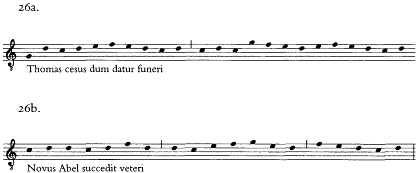
the Mass was copied at St. Peter's by May 1461, this Mass may have accompanied a major event in the term of Pius II; moreover, its probable composer, Caron, may have worked in Rome at about this time. Rather than an association with Thomas Parentucelli, who as Pope Nicholas V was not a martyr,[3] the metaphorical juxtaposition of Thomas with Abel seems a politically apt description of Thomas Palaeologus, the prince of Achaea. He was one of the two surviving brothers of Byzantium's last emperor, Constantine XI, and heir to the throne at Constantinople.[4] Known in Italy as the Despot of Morea, Thomas fled his kingdom in the Peloponnesus in 1460 to avoid the Turkish onslaught led by the sultan Mehmed II.
Abel was in the Middle Ages a symbol both of Christ and of a pilgrim, and because of the primacy he was considered to have in heaven, St. Benedict compared the papacy to him.[5] However, the analogy with Abel is particularly fitting because the sultan's attack followed shortly
[3] However, the humanist Antonio Agli called Nicholas a martyr based not on the shedding of blood but on his efforts as a "guardian and pastor of the Church"; and the pope's biographer Michele Canensi described Nicholas as a martyr on similar grounds (Charles Stinger, The Renaissance in Rome , 173). Epitaphs written for his death do not portray him as a martyr; see Iiro Kajanto and Ulla Nyberg, Papal Epigraphy in Renaissance Rome , 53-58.
[4] The fullest account of the conflict and exile is given in Kenneth Setton, The Papacy and the Levant (1204-1571) , 2: 196-230.
[5] Ad de Vries, Dictionary of Symbols and Imagery , 1.
an armed assault on Thomas by troops belonging to his brother Demetrius. While Demetrius capitulated to Mehmed and offered his daughter for the sultan's harem, Thomas won the undying gratitude of Pius II by bringing with him to Italy the head of St. Andrew, the first apostle and the brother of St. Peter. Described by contemporaries as a man full of grief, Thomas Palaeologus arrived in Rome at the head of a train of seventy horses on 7 March 1461—a date with particular importance in mid-fifteenth-century Rome—and the honors bestowed upon him are reported to have continued for weeks.[6] Pius II presented him with the Golden Rose, the symbol of virtue that popes had long bestowed on emperors and kings, and set him up in the palace near SS. Quattro Coronati with an annual pension of 6,000 ducats.[7]
It could not have been coincidental that Palaeologus arrived in Rome with seventy horses on 7 March, the feast day of St. Thomas Aquinas. Palaeologus had been in Italy long enough for him (or more probably Pius II) to plan the date of his arrival in Rome, as well as all of the festivities arranged to greet him. He had reached Venice by the end of July 1460, and then gone to Ancona at Pius's invitation on 16 November, almost four months before coming to Rome. According to a tradition that extended throughout the Renaissance, important celebrations such as the signing of a treaty or the arrival of a visiting dignitary were often carefully timed so as to coincide with some auspicious anniversary. For his coronation as Holy Roman Emperor in 1433, Sigismund entered Rome on Ascension Sunday; when Paul II honored the treaty known as the Peace of Italy, he did so by issuing a commemorative medal and by publicly announcing the achievement at a time and place with a particular significance for his Venetian heritage—in the basilica St. Mark's on 25 April 1468, St. Mark's day; and in the sixteenth century the Medici rulers Pope Leo X and Duke Cosimo I took particular pains to coordinate ceremonial events and birthdays, election days, or other personal "lucky" days, thereby mak-
[6] Ludwig Pastor, History of the Popes, from the Close of the Middle Ages , 3:250-52.
[7] P. M. J. Rock, "Golden Rose," 629. On a possible association of the Masses on O rosa bella with presentations of the Golden Rose, see Rebecca Gerber, "The Manuscript Trent, Castello del Buonconsiglio, 88: A Study of Fifteenth-Century Manuscript Transmission and Repertory," 128-32.
ing it seem as if the celebration of the moment "had been predestined by divine plan."[8] This type of planning extended beyond human events to architectural ones as well. Leon Battista Alberti, in his treatise On the Art of Building , reports a belief that even the day a building was begun should be carefully considered.[9]
The appearance of Palaeologus and the feast day for Aquinas were both momentous occasions in Rome of 1461. As the deposed heir to the throne of Constantinople, Palaeologus was for Pius a politically useful symbol of the Turkish peril. He would soon assist the pope in trying, albeit fruitlessly, to raise money and men for the crusade. Furthermore, his residence in Rome gave substance to the accord worked out not long before between the Greek and Roman churches. And with regard to Thomas Aquinas, solemn celebrations of his feast day were a modern Roman innovation, dating from guidelines formulated only years before under Nicholas V. As John O'Malley has shown, Nicholas gave the feast a unique prominence, one beyond that of "any other non-biblical saint, even ... Augustine."[10] Accordingly the occasion was to be observed every year in a service at Santa Maria sopra Minerva with the participation of all the curial cardinals. The papal choir sang Mass, there was a sermon, and the Apostolic Palace was accorded a holiday, all of which gave the feast a special liturgical standing. In the sermon he had delivered on this feast day in 1457, the humanist theologian Lorenzo Valla had paired Aquinas with one of the fathers of the Greek church, John of Damascus. In so doing he had attempted to reconcile scholastic thought and methods, as represented by Aquinas, with Patristic teachings. This pairing was but one of five couplings of Greek and Latin fathers, each in one way designed to show how the Greek fathers had contributed to the development of
[8] Roberto Weiss discusses the ceremonies of Paul II in Un umanista Veneziano: Papa Paolo II , 43 and 54-55; on the Medici, see Janet Cox-Rearick, Dynasty and Destiny in Medici Art , 258. Charles VIII doubtless intended to return to Rome from Naples on the Feast of St. Petronilla, the patron saint of the French chapel at St. Peter's, but he arrived the next day, I June 1495 (Kathleen Weil-Garris Brandt, "Michelangelo's Pietà for the Cappella del Re di Francia," 79 and 96, n. 30).
[9] Leon Battista Alberti, On the Art of Building , 59.
[10] John O'Malley, "The Feast of Thomas Aquinas in Renaissance Rome: A Neglected Document and Its Import," 24.
their Latin counterparts.[11] The pope and his resident theologians would have seen the arrival of the Greek Thomas on 7 March 1461 as an exceptional opportunity for associating the Aquinas feast with reconciliation between East and West.
A description of Paleologus as a new Abel is entirely in keeping with contemporary rhetorical practices, which saw in living figures new incarnations of individuals from antiquity. Thus to portray the feared Alfonso of Calabria, who threatened to sack Rome in the summer of 1482, the diarist Jacopo Gherardi called him a "novus Hannibal."[12] Paleologus arrived at a time when martyrdom had become "a leitmotiv of the restored Roman papacy."[13] Rome was then particularly occupied with artistic and literary depictions of martyrs, with Nicholas defining martyrdom broadly in terms of Christian struggles and suffering. Because Aquinas was not a martyr, chants in his honor, however correct liturgically, could not express the attribute that suited the political goals of Pius and the personal situation of Paleologus. The "borrowing" of a cantus firmus from a martyred saint may have seemed a rhetorically appropriate way to honor the arrival of an exiled and betrayed Thomas. Aside from his own sufferings, his responsibility for bringing the head of St. Andrew to St. Peter's would have constituted service enough.[14]
If the Missa Thomas cesus was indeed sung to greet Palaeologus, then the ceremonies of the day symbolically linked three Thomases: Palaeologus arrived on the feast of Aquinas while the choir, doubtless the papal choir, sang a Mass based on a chant for St. Thomas Becket. The choice of cantus firmus welcomed the fugitive Thomas as a living martyr, a "new Abel" victim of a "new Caen." Certain musical features of the Mass seem especially relevant for the occasion. The Credo text is truncated, omitting the "Filioque" clause and the reference to the
[11] Salvatore Camporeale, Lorenzo Valla tra medioevo e rinascimento: Encomium s. Thomae—1457 , 50.
[12] Jacopo Gherardi da Volterra, Il diario romano, 109 .
[13] Stinger, The Renaissance in Rome , 177; see his discussion on 170-79.
[14] Ruth Olitsky Rubinstein, "Pius II's Piazza S. Pietro and St. Andrew's Head," 221-30, describes the importance of this event to Pius and the elaborate ceremonies to greet the samt's head, including the singing of a hymn with a text "in sapphics composed for Pius by Agapito di Cencio dei Rustici" (p. 237).
apostolic church that had long troubled relations between Rome and Constantinople. Ruth Hannas's theory that these Credo deletions were politically motivated, that they were an attempt to conciliate the Greeks, has been rightly qualified.[15] Credo omissions, like those from other parts of the Mass Ordinary, were too common for them all to serve the same purpose. Nevertheless, given the possible connection with Paleologus, this theory is well suited for the Missa Thomas cesus .
Among other potentially relevant musical details, the Mass has an unusual conflicting signature, with one flat in the contra part but none in the cantus, tenor, or bass parts. This combination applies to all sections but the Et incarnatus and the Pleni-Osanna I, which have no signature flats at all.[16] This appears to have little to do with the relative range of the contra part. In some movements the range of the contra voice (G-a') is just one note higher than that of the tenor (F-g, or G-g); in others (Et in terra and the entire Sanctus) the contra and tenor move in identical ranges. Thus it is unlike Compère's chanson Ung franc archier , a piece with one flat for the superius, tenor, and bass but two for the contra. Compère thus accommodates a canon at the fifth below between the superius and contra. The single flatted part in the Missa Thomas cesus , as one might imagine, causes several problems of musica ficta that can only be solved by negating the flat. Example 27 presents one instance from the Christe that results in a simultaneous


A symbolic meaning of the flatted part seems plausible,[17] in particular, one related to the oration on St. Thomas Aquinas preached by Lorenzo Valla in 1457. After pairing Aquinas with John of Damascus as the last of the five Greek-Latin theological couples, Valla compared each couple to a representative musical instrument; and then, pursuing
[15] Ruth Hannas, "Concerning Deletions in the Polyphonic Mass Credo," 155. Replies came from Sylvia Kenney, Walter Frye and the Countenance Angloise , 170-72; Margaret Bent and Ian Bent, "Dufay, Dunstable, Plummer—A New Source," 413-14; and Geoffrey Chew, "The Early Cyclic Mass as an Expression of Royal and Papal Supremacy," 260-62.
[16] There is also a flat at the very beginning of the tenor part of the Kyrie II, for the first line only, a line without any Bs to flat. This seems likely a scribal error and a sign of how rare this conflicting signature was.
[17] Edward E. Lowinsky discusses symbolic usage in "The Function of Conflicting Signatures in Early Polyphonic Music," 250-54.
EXAMPLE 27. Ficta problem at cadence in Missa Thomas cesus , Christe, mm. 6-9

his musical metaphor, he assigned to Aquinas and John of Damascus the extraordinary role of the fifth tetrachord, a complex allusion to the Boethian double octave and the greater perfect system. In his study of Valla's oration, Salvatore Camporeale suggests the following interpretation: Since the four tetrachords of the Boethian double octave (A to D, D to G, and so on), do not account for the note


Musical symbolism of another kind may have shaped the setting of the cantus firmus. Each time the B section of the cantus firmus makes its appearance in a cut-C section, the first two notes, C-D, are emphasized. These opening two pitches, although they do not constitute a phrase unit either syntactically or musically in the chant, are persistently isolated. Several breves of rest separate these notes from those that follow, and they are themselves set in long values. Counting the number of breves allotted to each of these two notes, they last 3+3 breves at the start of the Christe, 4+4 in the Qui tollis, 6+6 in the Et
[18] Camporeale, Lorenzo Valla tra medioevo e rinascimento , 52-54.
EXAMPLE 28. Comparison of Missa Thomas cesus with Caron, Le despourveu infortunée , and Joye, Mercy, mon dueil
EXAMPLE 28A . Le despourveu infortunée , mm. 1-9

EXAMPLE 28B . Missa Thomas , Qui tollis, mm. 1-10

EXAMPLE 28C . Missa Thomas , Et incarnatus, mm. 1-11

EXAMPLE 28D . Le despourveu infortunée , mm. 4-11

EXAMPLE 28E . Missa Thomas , Benedictus, mm. 1-7

EXAMPLE 28F . Mercy, mon dueil , mm. 1-7

incarnatus, 3+4 in the Benedictus, and 4+4 in the Agnus III. One wonders if what is being emphasized is not the name "Thomas" spelled with the hexachord syllables sol and la. Parallels occur later in Josquin's Missa Hercules and also at the end of Du Fay's motet and Mass Ave regina , when the "fa" syllable of his name occurs on an


Finally, a possible musical-textual reference to the deposed ruler points to Caron as the composer of the Mass. By quoting chansons in the contrapuntal voices of polyphonic Masses, as I argue in chapter 10, Renaissance composers could allude to the unsung chanson texts as a commentary on the text of the Mass Ordinary. Chanson quotations (or citations of chant) could also refer to a specific event or person. As in the Masses by Caron discussed in chapter 10, the Missa Thomas appears to quote from one of Caron's own chansons. Le despourveu infortunée by Caron has both melodic and rhythmic identity in two voices with the Qui tollis and the Et incarnatus movements. Example 28a shows the superius and tenor voices of this chanson. They match the opening superius and contra duet of the Qui tollis for the first phrase (Ex. 28b). The latter half of this chanson phrase returns at the beginning of the Et incarnatus, again with a note-for-note identity, except for the metrically elongated cadence (Exs. 28c-d).
The text of the chanson could not be more appropriate as an expression of the state of exile in which the aggrieved Thomas Paleologus found himself:
The unfortunate deprived one,
Incessantly surrounded
By grief, regrets, and tears,
I find myself shut out from any succour,
And abandoned to all evil.
I am piteously rewarded
And very badly cared for;
Fortune by her evil turns makes me
The unfortunate deprived one, etc .
More than anyone else I am badly dealt with,
For Hope has turned its back on me;
So my situation goes contrarily along.
I can with reason blame Love,
When he appointed me to be
The unfortunate deprived one, etc .[19]
By association with the Mass text, the allusion of the chanson melody could thus be understood in the Qui tollis as a plea for mercy on behalf of "the unfortunate one deprived" of his kingdom; and in the Et incarnatus as a statement of Paleologus's personal fate: "And he was incarnate the unfortunate deprived one." This tune, or one related to it, begins the Benedictus (Exs. 28e-f). Among the possible references is the tenor of Joye's Mercy, mon dueil , "Have mercy, my grief, I beg of thee."[20]
Aside from the citation of one of his own chansons, trait after trait of the Missa Thomas cesus appears in the five Masses securely attributed to Caron. The handling of the tenor and the relatively frequent cadences are both characteristic of Caron. His Masses never repeat the Osanna I as the Osanna II; as in the Missa Thomas , the Osanna II receives its own setting. And as happens in the Missa Thomas , the Pleni and Benedictus of Caron's Missa Sanguis sanctorum both combine with the Osanna that follows. With regard to the three sections of the Kyrie, all of those composed by Caron are for four voices rather than four in the Kyries and only three in the Christe; it is also characteristic, though not uniform, for all voices to begin these sections together.
Conflicting signatures : The pattern of conflicting signatures has ample parallel in Caron's Masses. There are conflicting signatures in the Missa Clemens et benigna (



Mensuration signs : Caron's mensural tendencies prevail in the Missa Thomas (Table 23). The similarities are strong in the Kyrie and Gloria,
[19] The translation is by Max Knight, in Howard M. Brown, A Florentine Chansonnier from the Time of Lorenzo the Magnificent: Florence, Biblioteca Nazionale Centrale MS Banco Rari 229 , text volume, p. 251.
[20] Translation in Leeman Perkins and Howard Garey, The Mellon Chansonnier , 2: 278-79.
a bit less so in the Credo, a movement marked by its lack of uniformity in Caron's Masses. Only the Agnus departs from mensural patterns that occur in Caron's Masses; but here as well, since no two Masses by Caron have an identical mensural scheme, this is not a serious difference. Indeed, if there is an identifiable mensural pattern in Caron's Agnus movements, it is that they replicate the sequence of mensural signs just heard in the Sanctus: The Agnus movements of the Missa Clemens, Missa Jesus autem transiens , and also the Missa Thomas simply repeat the succession of mensural signs used in the Sanctus. The other Masses diverge only on the use of a diminution sign for the final section of text.
Structural parallels : Caron never repeats the music from one sub-movement in another. Nevertheless, in two of his Masses there are sections with significant structural parallels. Caron pairs the Gloria and Credo of his Missa Jesus autem transiens by giving them the same tenor (as does Du Fay in his L'homme armé and Se la face ay pale Masses); and for the Cum Sancto and Confiteor sections, the contrapuntal voices are extremely close.[21] Another instance does not involve exact melodic repetition in any voice. In the Sanctus and Agnus of the Missa L'homme armé , the beginnings of two submovements are paired struc-turally (Table 24). The first twenty-three measures of the Sanctus and Agnus I and the first twenty-two of the Benedictus and Agnus II adhere to similar plans. Caron's choice of phrase length, cadence points, contrapuntal pairings, rhythms and meters, and textures follow each other almost measure by measure. Only once do the similarities extend to motive, and only for a brief instance of mid-phrase counterpoint.
In this latter structural sense the Missa Thomas cesus has two pairs of related movements. The Qui tollis and Benedictus follow each other phrase by phrase, as do also the Pleni and Agnus II. In these movements the composer avoids outright duplication, creating an aural impression of variation rather than repeat. For the most part the parallels do not extend to motives, although the cantus firmus segments are the same, and the first superius measures of the Benedictus clearly relate to those of the Qui tollis. Also in the Pleni and Agnus II the contra parts follow each other closely at the beginning, as do the bass parts. in the
[21] James C. Thomson, An Introduction to Philippe (?) Caron , 11, considers the Confiteor a "polyphonic parody" of the Cure Sancto.
EXAMPLE 29. Cadential pattern in (a) Missa Thomas , Patrem, mm. 65-68 (contra omitted); and (b) Patrein, mm. 72-75 (contra omitted)
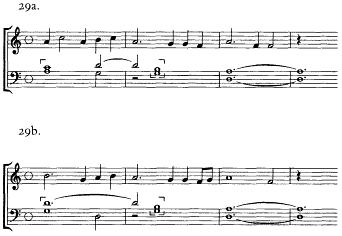
last duet.[22] These twosubmovements are the only times that the B phrase of the cantus firmus occurs in tempus perfectum . But instead of pairing these sections by building them out of the same motives, the composer depends on correspondences between cadences, the presence or absence of strict imitation, the use of duets, and the equality of phrase lengths. Details of the similarities are listed in Table 25.
Cadence type : This G-mode Mass has a number of unusually prominent Phrygian cadences. There are twenty-three in all, one in every submovement except the Qui tollis, and as many as four in the Patrem. Fourteen of the cadences take the distinctive three-voice form shown in Example 29, what I shall call a "plagal-Phrygian cadence," because while the tenor and cantus cadence on a, the other voices make a plagal movement from G to D.[23] It receives particular emphasis throughout the Credo, where it is heard five times because the composer
[22] Compare the Pleni, mm. 1-6 and 21-23; and Agnus II, mm. 1-7 and 21-23.
[23] This cadence, called by theorists simply a clausula in mi , was common well into the sixteenth century; see Bernhard Meier, The Modes of Classical Vocal Polyphony , 96-99.
chose to repeat the underlying cantus firmus segment. Although there are no

No composer made greater use of the plagal-Phrygian cadence than Caron. Most of his Masses have many: The Missa L'homme armé has nine, the Missa Jesus autem transiens has ten, as do the four extant movements of the Missa Sanguis sanctorum , and the Missa Clemens et benigna has twelve. In this sense the Missa Accueilly is unusual because it has only one. As in Caron's chansons and the Missa Thomas , the cadence often comes in Caron's Masses during the penultimate phrase (as in Ex. 29).[24] Busnois, in so many ways stylistically like Caron, also relies on this cadential pattern more than others. Although in his Missa L'homme armé there are only three, and in the four movements of the Missa Quand ce vendra there are six, sixteen occur in the Missa O crux lignum . Yet Busnois differs from Caron cadentially in that he is more apt to repeat cadences on the same pitch, and other aspects of the Missa Thomas —the mensuration scheme, the separate Osanna II—are not typical of Busnois. In the Naples L'homme armé Masses the presence of this cadence varies greatly: Number 1 has only one, number 6 has eight or nine, while number 2, stylistically the most progressive, has seventeen (a total that excludes from consideration the incomplete Kyrie I).[25] And Vincenet, who is too prone to duets to be confused with Caron (along with other formal differences), has eleven in his Missa O gloriosa regina .
Among other composers, this type of Phrygian cadence is less evident in the Masses of Johannes Touront, a master who otherwise bears
[24] Regarding the prevalence of this cadence in Caron's chansons, see Thompson, An Introduction to Philippe (?) Caron , 38. He and others have dubbed this an "undermined" cadence, referring to the (presumed) necessity to lower the seventh degree at cadences, an assumption not always warranted.
[25] Regarding the stylistic differences of Mass no. 2, see Cohen, The Six Anonymous L'Homme Armé Masses in Naples, Biblioteca Nazionale, MS. VI E 40 , 44 and 60; and Barbara Haggh, Communication to JAMS . And in the anonymous SPB80 Missa (fols. 122-29) motivically related to Caron's Masses, this cadence type occurs only once.
melodic and rhythmic comparison with Caron and Busnois. He has many Phrygian cadences in his Missa Monyel and Missa Tertii toni , but few in this pattern. There are four of these cadences in Ockeghem's Missa Ecce ancilla Domini , four in his Missa L'homme armé , five in the Missa Mi mi (on E), and four in the three movements of his Missa (à5). However, aside from his use of this cadence being more temperate than Caron's, Ockeghem treats it in a different manner structurally. He customarily locates these cadences either well into the interior of a submovement or at the very end. Mass cycles by Du Fay have comparatively few Phrygian cadences and almost none of this plagal variety (which is yet another point of contrast with the Missa Caput once attributed to him—it has nine of these cadences). Nor is it prevalent in the Masses of Faugues.
Motives
Caron's melodic stamp appears in several movements. The Pleni of the Missa Thomas and the Benedictus of Caron's Missa Clemens have the same beginning (Ex. 30). On the one hand, this particular melodic similarity is not by itself significant, because the motive is common, especially in settings of the Sanctus (chapter 6, Ex. 5). On the other hand, the coincidence extends beyond the opening motive. The only G-mode occurrences of the motive (it is most frequent in mode 5) aside from these are in Caron's Missa L'homme armé (Sanctus, m. 6) and earlier in the Missa Clemens at Domine Deus.[26] The rhythmic cast of this opening and the harmonic context contribute to the similarity here, as they do also in two other related movements, the Missa Thomas Agnus III and the Osanna I of the Missa Accueilly m'a la belle (Ex. 31), which are virtually identical in their openings. This last tune turns up again in the Christe of the anonymous three-voice Missa in SPB80 on folios 122-29 (chapter 6, Ex. 7).
Caron returned to this opening for the Kyrie II of the Missa Sanguis sanctorum (as in the third segment of Ex. 32b).[27] This time the rhythm is more animated. However, the Kyrie for this Mass also presents an-
[26] The continuations of each line extend the resemblance, and a neighboring movement, the Osanna I, also has a similar beginning.
[27] And also the four-voice entry in the Christe of the Missa Accueilly m'a la belle .
EXAMPLE 30. Motivic comparison of (a) Missa Thomas , Pleni, mm. 1-5; and (b) Caron, Missa Clemens , Benedictus, mm. 1-5
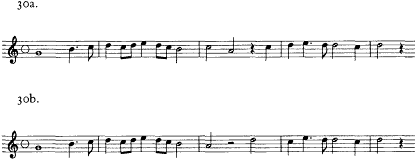
EXAMPLE 31. Harmonic and motivic comparison of (a) Missa Thomas , Agnus III, mm. 1-6; and (b) Caron, Missa Accueilly , Osanna I, mm. 1-6
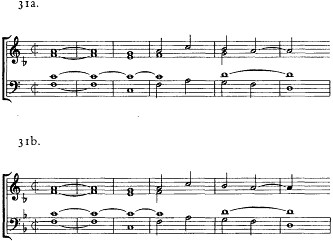
other type of motivic parallel with the Missa Thomas . It does not seem to matter that the two Masses are in different modes. Caron follows the same motivic series to begin the three sections of the Kyrie in each Mass, one centered on f, the other on g. Later in the Missa Sanguis sanctorum and the Missa Thomas there is a shared conclusion for the Sanctus. Each concludes with the plagal-Phrygian cadence described
EXAMPLE 32. Motivic comparison of (a) beginnings of Missa Thomas , Kyrie I, Christe, and Kyrie II; with (b) Caron, Missa Sanguis , Kyrie I, Christe, and Kyrie II
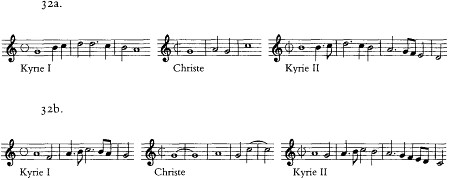
above, plus the postcadential descending sixth (from f to a) popular in chansons of Busnois, Hayne, Compère, and others. These twin cadences occur despite the different modes of the Sanctus and of the Osanna, which follows immediately.[28]
As in the Missa Jesus autem transiens and the Missa Thomas , the "second tune" of the L'homme armé Masses occupies an important position as an interior motive. It is not simply that this melodic cliché itself is present but that the way in which it is handled in both Masses is the same. When the tenor cantus firmus reaches the note d, usually at a cadence point, the top voice launches into this familiar motive or a variant. Example 33 juxtaposes the Missa Jesus Kyrie I (mm. 12-16) and the Missa Thomas Patrem (mm. 4-8); and the Missa Jesus Sanctus (mm. 30-34) and Missa Thomas Et in terra (mm. 29-34). The similarities in this last example extend to the counterpoint.[29]
[28] In the Missa Sanguis sanctorum this figure also follows this type of Phrygian cadence in the Et in terra at rehearsal letter G in Thomson's edition (Philippe Caron, The Complete Works of Philippe (?) Caron ).
[29] Other instances are found in the Missa Jesus : Confiteor (m. 12), Sanctus (m. 16), and Agnus I (m. 12); and the Missa Thomas : Christe (m. 28), Et in terra (m. 15), Et incarnatus (m. 62), Confiteor (m. 4), Benedictus (m. 43), and Agnus I (m. 30). The last two omit the first note.
EXAMPLE 33. Motivic comparison of Missa Thomas and Caron, Missa Jesus
EXAMPLE 33A . (i) Missa Thomas , Patrem, mm. 4-8, and (ii) Caron, Missa Jesus , Kyrie I, mm. 12-16

EXAMPLE 33B . (i) Missa Thomas , Et in terra, mm. 29-34, and (ii) Caron, Missa Jesus , Sanctus, mm. 30-34

Imitation
In general, imitation intrudes only sporadically in tutti passages in the Missa Thomas and in all of Caron's Masses. It stands out when it occurs. In duos and trios imitation does not always appear at phrase beginnings, and it is frequently associated with sequential patterns, often at the distance of a single minim or semibreve a fifth or an octave apart. Imitative motives range from improvisatory formulas to more contrived, and less strict, counterpoint. The same can be said for counterpoint that proceeds in parallel thirds, sixths, or tenths. One can generalize that throughout the latter half of the century, composers like Hayne who favored these sweet consonances also used imitation in more or less
EXAMPLE 34. Comparison of cadences in (a) Caron, Missa Clemens , Osanna II, mm. 9-10; and (b) Missa Thomas , Et incarnatus, mm. 60-64
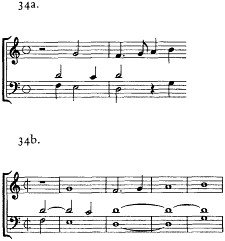
equal quantities, as if one facilitated the other. Speaking specifically of Caron's Mass style, passages of imitation and parallel consonances are absent in equal measure. They come and go discretely.
Characteristic of polyphony in the generation before imitation became pervasive is a more disjunct approach to phrasing. Often after a cadence the lower voices engage in a breve or two of contrapuntal filler leading to an entrance with the next phrase of text. At times transitions are nothing more than a sustained pitch or plagal fall in the bass; sometimes they rely on a fauxbourdon cadential formula or on more extended passages of free counterpoint. Occasionally there is no transition whatsoever, only a sustained note or chord in the lower voices, or in the duets not even that. Without relying on imitation to achieve elided phrases, Caron's Masses and the Missa Thomas often introduce the superius in the midst of a cadence in the lower voices. While the tenor is suspended against the bass, the superius enters a fourth above the tenor, creating a dissonant diminished fourth when the subsemitonium modi is raised for the cadence. In Example 34 I have selected two from many because of the characteristic dotted rhythmic pattern of the superius.
Against all of these similarities, the only discrepancy that the Missa Thomas has with Masses ascribed to Caron concerns the number of voices used to begin movements. Caron favors duet beginnings for the Gloria, Credo, Sanctus, and Agnus, while the principal movements of the Missa Thomas all begin with four voices. Compared to the wealth of stylistic resemblances, this does not seem a serious idiosyncrasy.